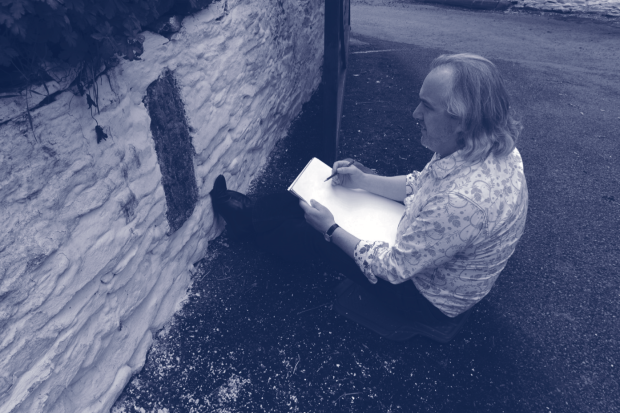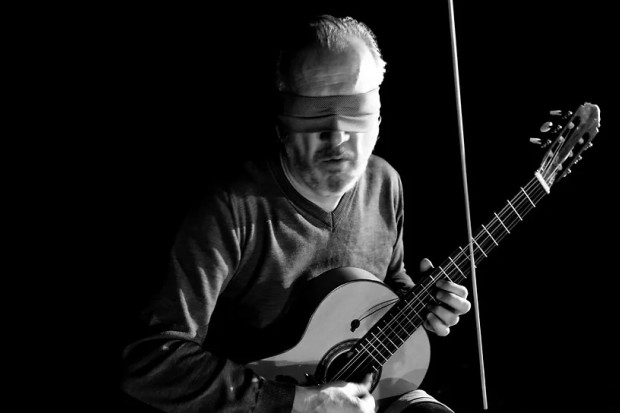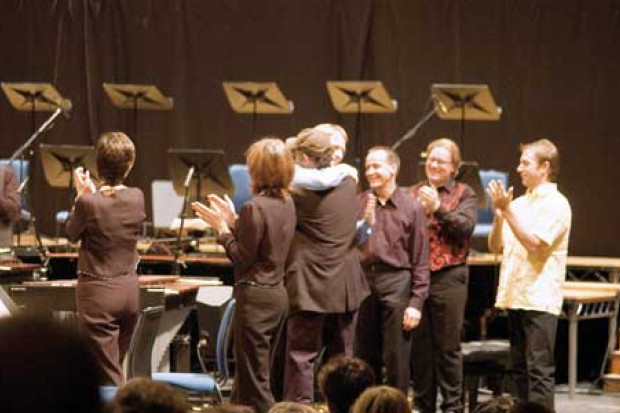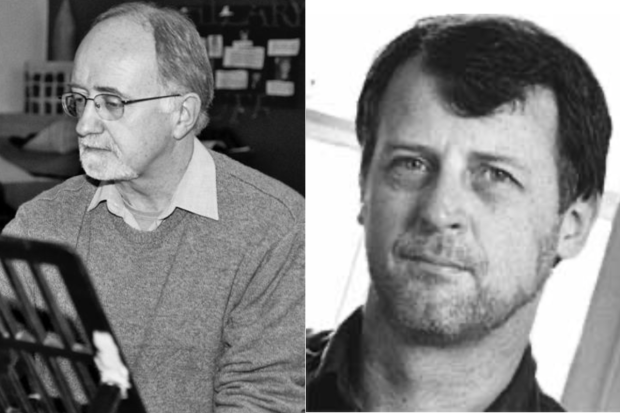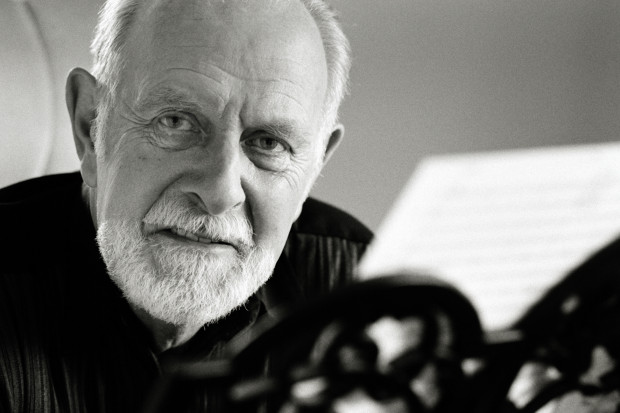
Benjamin Dwyer
A Bouncer's Viewpoint
The position of Director of the Bank of Ireland Mostly Modern Series and Festival brings many responsibilities. As the organisation is a small one, the title of Director is, to all extents and purposes, a cover up, in the sense that it completely hides the various other types of work I have to do. Being one of only two people running Mostly Modern, I have to get down there and dirty my hands just like well, just like the other fifty per cent of the organisation. Not surprisingly, I sometimes feel like an actor having to perform many roles.
The most extraordinary and unexpected role I had to take on was that of ‘the bouncer’. Now I had always wanted to get inside the mind of the bouncer – you know him: the shaved-headed rugby player who shifts uneasily at nightclub and pub doorways trying not to look cold. He always wears a uniform of black – black trousers, a black polo neck and a black jacket (where at all possible, a black leather jacket!). Lately, he has taken to wearing a Mission Impossible-style ear-piece (a wire connecting him, one imagines, to some bouncer central headquarters, perhaps, by the look of them, at the Civic Offices, Wood Quay, through which he receives ‘highly classified’ and ‘updated’ profiles on the poor and wretched potential customer). Such is the threat imposed by the customer that some establishments feel the need to hire as many as three bouncers. The logic being, on the one hand, to turn the experience of entering the place into an ordeal similar to that of Bill Clinton’s live trial at the Starr Enquiry, and, on the other, to make the customer feel strangely superior for having actually entered successfully. Yes, I’ve always wanted to know what makes a bouncer tick.
Well, during one Mostly Modern concert the opportunity came, uninvited may I say, for me to enter the world of ‘bouncerhood’. Peter Wells, the recorder player from New Zealand, was featured. The atmosphere in the hall was good and the seats were being steadily occupied. It was going to be, as far as audience numbers were concerned, a real success. And to expel any doubts, twenty students from God-knows-where arrived at the last minute and we duly made room for them. Yes, it was a promoter’s dream: ‘the full house’!
So Peter Wells arrived on stage to a thunderous applause, things quieted down and he began his performance. The soft whistle tones and phrases he produced from his quiet instrument were soon interrupted by some light giggling. Now this isn’t always such a grave offence; it often happens at the start of a contemporary music recital, particularly if the performer is a somewhat animated character as Peter is. But for some reason the giggling didn’t stop. It was spreading before my eyes. I watched from the back of the room while quiet giggling developed into louder guffaws and snorts. Not only was it spreading steadily, but it was also beginning to disturb the performer and the rest of the audience who came to hear him. I realised then that I had a crisis on my hands. Normally very reluctant to intervene, it was fast becoming clear that something would have to be done. I moved in for the kill. I honed in on a row of five or six of the worst offenders and very firmly evicted them. (Not without, I’m proud to say, a certain use of body language that gave the impression that I was willing to back up my demands with ‘whatever force was deemed necessary’.) Yes, my bouncer brethren would have been very proud of me. Each offender was firmly pointed at and silently (but all the more effectively for that!) instructed to leave by way of transferring the pointed finger from the offender to the door - ‘you … door … you … door … ’ – five times. The effect was dramatic and immediate. Each accused stood up with head down in shame and left the room quietly. I was on a good run here. I wasn’t at all sure if the sixth person was an offender but I was beginning to feel the adrenaline flow, the power tingle in my finger tips. The sixth person looked up with open, deploring eyes. They said, ‘I’m not guilty, please let me stay, please don’t humiliate me’. A moment ensued while the jury in my head debated his innocence; a timeless, glorious moment where the access of power ran freely through me. No, it would not do; he had to be guilty also. The final expulsion was his, and it was all the more dramatic for being the last, and for him having the audacity to plead innocence. My finger pointed to him and then violently to the door. There was to be no appeal. He must go, which he duly did, head low, in shame.
During the remainder of the concert my blood pumped and banged through my veins, celebrating my victory. So this is what the bouncer feels. This is why he subjects himself to freezing nights in doorways with apparent disregard for the cold. I had arrived into the brotherhood. I had finally understood the God to which it prays: power!
Well, I think this is a funny story and I’ve often told it to friends in a pub – when I’ve been lucky enough to get in – the bouncers still don’t seem to recognise that I’m one of them! I tell it here for another reason. The reason is that it highlights what I now consider to have been a failure on my part as Director of Mostly Modem. That failure was to assume that the more people I have at my concerts the better. The prospect of having a full house was so attractive that no thought was given to the type of audience I might be ushering into the room. In the rush to prove how successful Mostly Modem was as a series I let down my performer and my loyal audience. In the zealous crusade for ‘bums on seats’ I was partially responsible for the demeaning of the musical event and experience.
But here, I’m caught between a rock and a hard place. For I have also to prove to the Arts Council and the Bank of Ireland that Mostly Modem is successful, and success is, I’m afraid, strongly interpreted these days in tenm of audience numbers. On paper I can say that for the Peter Wells concert Mostly Modem had a full house. For anyone reading my end of year report this would clearly be seen as a success. The fact that a large percentage of my audience was completely incapable of appreciating the music on offer, to the extent that the recital was severely disturbed, goes unregistered. You might counterargue that everybody should be exposed to contemporary music. I agree. That is why we offer our recitals free of charge. But when the gap between the music and the listener is so great that the ‘contract’ between performer and audience, which is necessary for the musical experience to have value at all, is broken, perhaps it’s time to challenge the thinking on this.
You might also argue (as I myself have done in the past) that the musical event should also be an educational one. There is no doubt that this should be the case. However, to place all the responsibility of educating the listener on the musical performance is to misunderstand and belittle the experience that is supposed to be had at such an event. Art is for everyone but not everyone is for art. The more involved in the promotion of music I become (and I’ve been doing this for fifteen years now), the more I believe in this statement. And I know that when I say this that I am veering dangerously close to sounding undemocratic and politically incorrect. I can already hear the accusations of musical snobbery and elitism. But it is my profound belief that to try to bring art to an audience neither equipped nor interested in receiving it is to diminish the former and patronise the latter. The arrogant assumption that everyone simply has to be brought into the realm of art smacks, to me, of an evangelism that is less patronising than it is dishonest in that the crusade probably has more to do with consumerist thinking than with an educational altruism.
Whenever I have come across this attempt to embrace the masses, I think the music (and therefore the musical experience) has suffered. There are thousands of examples, but some that come to mind include the ‘Hooked on Classics’ recordings, which were once very popular, and in which the constant drumbeat completely destroys the very fabric of the music’s inner pulse. Nigel Kennedy’s attempts at bringing already very well-known music – Vivaldi’s Four Seasons – to an even greater audience were successful, but at the cost of transforming the music beyond what the composer himself would recognise as his. Even the small opera companies who, for the best reasons in the world, tour scaled down versions of operas, do, in the end, a disservice to the music and the composer, who should, at least, be in a position to make the reduction himself or herself. Although in the case of Mozart this is somewhat difficult! Worst of all was the millennium celebration concert, Messiah XXI, held here in Dublin. At the cost of over £700,000 of tax-payer’s money, poor Handel received the butcher treatment, having his masterpiece transformed into the worst sort of 1970s disco drivel, sounding more at home in an episode of Starsky and Hutch than as a celebration of Christ. And all this in the service of bringing the music closer to the masses! When a spectacle like this gets the backing of the government, the President of Ireland and RTÉ, one is almost inclined to agree with the hard-line attitude of Debussy when he said,’Truly music ought to have been a hermetic science, guarded by texts of such length and difficulty that it would certainly discourage the herd of people who use it as casually as they would a pocket handkerchief.’ [1]
Art cannot always survive the imposed dual responsibility of educating everybody and being accessible. Really, it should be the other way round. People (those who wish to) must meet art at least halfway. It is a feature of the late twentieth century (and an ever-increasing one in more recent times) that market forces in all areas of the ‘music industry’ create pressures on promoters to present arts events in the most accessible way to as many people as possible. As there is an educational problem in relation to the arts in Ireland, that brief cannot often be discharged without some negative transformation of the art promoted. In many ways, the Arts Council is doing a very good job, considering the historical problem it has inherited. The government has never placed importance on arts education in this country. The appalling number of Leaving Certificate students sitting music (2% in 1996, down from an all-time high of 2.9% in 1985) is proof of this.[2] And, as in the past, when the government negligently left the whole education system in the hands of the religious, it now largely leaves the responsibility of arts education in the hands of the Arts Council, and through it, to the arts promoters. At the same time, state subsidy of the arts in Ireland remains among the lowest in Europe. Figures for 1997 show that, per capita, Ireland comes eighth behind other European regions, including Northern Ireland (£17.32), Scotland (£27.84), England (£24.23), Finland (38.51) and Sweden (£62.14). Ireland, in the midst of the much-quoted Celtic Tiger, can only manage a meagre £12.36 per capita. This is a rather pathetic statistic, particularly in light of the government’s constant (if not credible) claim about Ireland being a culturally rich country.[3]
One gets the feeling, therefore, that the government is, in some ways, ‘passing the book’ of arts education to the Arts Council. Hence all the initiatives to have ‘audience development plans’, ‘outreach programmes’ and ‘education initiatives’. I don’t say that these are of themselves bad initiatives. They are indeed very good initiatives, but they should assist an already healthy arts education system, not replace it.
It is possible that the market-driven environment in which the arts operate today is having a negative effect on artists. Because consumerism values quantity over quality, it naturally comes into conflict with art, which builds its precepts on completely different values. Despite the existence of Aosdána, which provides, in some cases, an annual financial support for creative artists, there is still a real need for the artist to be commissioned. In the area of music I see this as a very important aspect for composers as it obviously provides extra money, but, more significantly, it also seems to provide a benchmark by which he or she can be judged successful. I heard recently of one Irish composer boasting that he had so many thousands of pounds worth of commissions for the forthcoming year. I can understand the boast (as a composer I also want to get commissions), but a strange aspect creeps in when money and the number of commissions are the only criteria for success. What sort of subliminal pressure does this place on the creative artist? Unfortunately, no real competent critical analyses of new music appears in the press, or any other area for that matter, that might act as a counter-balance to the above criteria for success. And if the success of an arts event is largely judged in terms of audience numbers, what message does this send to artists? Can they remain completely impartial in their artistic exploration if there is some unspoken understanding that they be successful in terms of audience numbers, that is, in terms of accessibility? Can they remain completely impartial in their artistic exploration if there is a pressure to get a minimum amount of commissions under their belt every year? Is there a connection between accessibility in the arts and success with commissions? I don’t have the answers to these questions, but I think it is worthwhile asking them.
If it is possible for creative artists to be influenced by a consumerist and market-driven environment, perhaps it is possible that arts organisations can also be. A few years ago, I went to a dance production given by a dance company I admired very much. The programme was typical of this company: high quality dance and choreography presented in a way that was always entertaining. Although I initially enjoyed the experience I was, for some reason, getting the feeling that rather than being challenged and engaged artistically (as I had expected) I was being somehow very skilfully nurtured into a cosy atmosphere that was, for me, somewhat disquieting. I slowly became aware that I was being enveloped in a cocoon where dancers and audience were drawn together, not in a mutual artistic experience, but rather in a strange contract where audience was celebrating not just the dance but itself at the dance. The way in which the audience was engaged resulted in a shifting of emphasis away from the sometimes very fine dancing. This was not, I felt, a result of some artistic statement about audience and performer and their relationships to each other, but merely an attempt to seduce the audience, which was, for all the wrong reasons, becoming the centre of the show. My worst fears were realised when, as a coup de grace, thousands of balloons were released not on the stage but on the audience. The response was a spontaneous orgiastic outburst, standing ovations, ecstatic applause, whoops and screams; the total manipulation of the audience was complete. It was a brilliant exercise in gaining adoration by allowing the members of the audience to adore themselves. In so doing, they became little more than a mob that was not expressing its enjoyment of a wonderful artistic experience but performing its enjoyment in its meaningless participation in the event. And as the reaction was a mob reaction, it marched its jackboots over any possibility of a meaningful individual response. I left the arena feeling very uncomfortable. I also felt duped, for this was ‘a successful event’. Whatever it was, it had little to do with art.
I think it’s worth making these points. And, who knows, maybe I exaggerate my experience of the dance show. But I do feel that art is not a product to be sold to as many customers as possible. It’s an opportunity to share something meaningful between that triumvirate – the artist, the performer and the audience. Art will not be understood in black and white terms – to force it to do so will deprive it of its mystery. And here I am reminded of David Mamet’s words: ‘Art is not meant to inform. It is a mystery. The true artist must, in these as in any other stultifying and confusing times, make his or her own way through both derision and subsidy.’
–
First published in JMI: The Journal of Music in Ireland, Vol. 1 No. 3 (March–April 2001), pp. 5–9.
Notes
I. Debussy in Pellormance. Edited by James R. Briscoe (Yale University Press, 1999)
2. Statistics from the essay ‘Tacit Approval’ by Martin Drury, The Boydell Papers (Music Network Publication, 1997).
3. Statistics from The Arts Plan 1999-2001 (The Arts Council).
4. David Mamet, Make-Believe Town: Essays and Remembrances (Faber and Faber, 1996).
Published on 1 March 2001
Benjamin Dwyer is a guitarist and composer and the author of 'Different Voices: Irish Music and Music in Ireland'. He is Professor of Music at Middlesex University's Faculty of Arts and Creative Industries.










